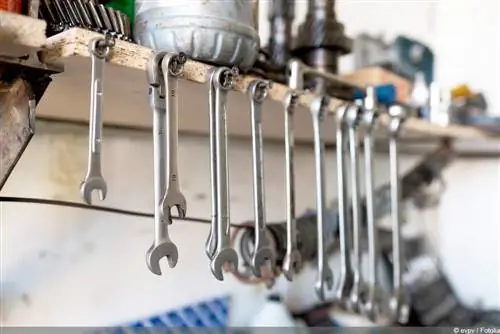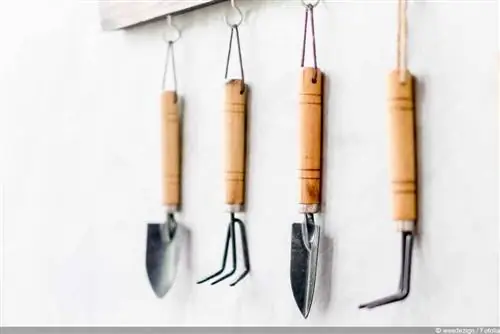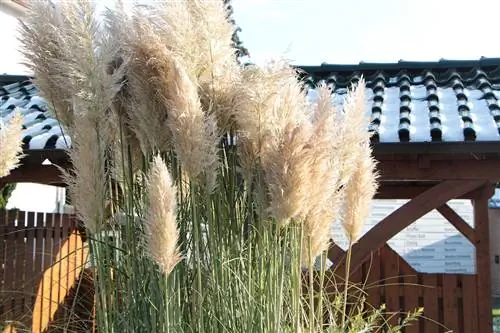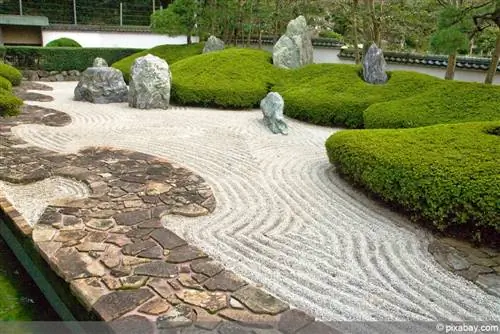- Author admin [email protected].
- Public 2023-12-17 03:39.
- Last modified 2025-01-24 12:45.
Clutter is not only annoying for the gardener, but extremely disadvantageous. If you're looking for your rake or a pair of secateurs and can't find them, you should take action. There are numerous possible solutions that you can use to tidy up your tool shed or garage. Hanging up garden tools is particularly effective, meaning you always have them quickly to hand.
Hanging up garden tools
You're probably wondering why hanging garden tools works so well? Several advantages arise from this. On the one hand, you can immediately see where the necessary equipment is located and, on the other hand, you always have a place where nothing can pile up. Clutter occurs when devices are stored on top of each other and left unused for long periods of time. If all devices, utensils and materials are hanging in an orderly manner on the wall, there can be no clutter. With the solutions below you can quickly build a wall mount for large and small devices yourself and require little to no manual skills.
Hook strips
Classic hook racks are still the best method today for safely hanging up numerous garden tools, having them available within a short time and keeping equipment cabinets tidy. You could drill hooks directly into the wall at regular intervals, although this is not necessarily recommended, especially in rental houses. Hook strips, on the other hand, carry the hooks and are attached directly to the wall with a few screws. This gives you plenty of hanging space as even just one board can support multiple hooks. However, you don't have to get to work with the drill straight away.
Hook rack made easy
Hook racks can be made from a variety of materials that you may already have on hand. For this variant you only need the following utensils:
- 1 x thicker rope or 1 x bamboo stick
- S-hooks in the desired quantity
The hook strip is installed as follows:
- If you use a rope, attach it using two hooks. These are located at the ends of the rope so that it can be attached using knots or loops. If you use a particularly long rope, you should use additional ring hooks so that the rope does not sag too far in the middle.
- Assembling a bamboo stick this way is a little more difficult. This is either attached directly to the wall with screws or placed on two objects and screwed to them. For example, robust cabinets or shelves that you have in the tool shed are suitable for this. Make sure the stick doesn't slip.
- Now simply hang the desired number of S-hooks on the rope or bamboo stick. There is no simpler method. This variant also offers the advantage that you can position the hooks differently without having to screw or drill.
With this variant, you can quickly create a hook rack that offers space for numerous garden tools. The only disadvantage to a rope or a bamboo stick is the maximum weight load.
Tip:
For light and small garden tools, you can make it even easier if you have a used coat rack with hooks. Screw these onto the wall in your workshop or shed and you'll have space for a variety of gardening tools, from scissors to planting shovels to brooms.
Wooden hook rack: instructions
The classic shape of a hook rack consists of a wooden slat that is equipped with hooks. For this you need the following materials:
- 1 x wooden strip in the desired length, 50 mm width, 20 mm thickness
- Wall hooks with U-profile in desired quantity
- 1 x drill
- Wood drill or self-tapping screws
- pencil
- Inch rule

Make sure that the wooden strip is not too long as it is more stable in a shorter length. In many cases a length of two meters is completely sufficient. You will also need at least four screws with a length of five to seven centimeters to attach the strip to the wall. The longer your hook rack, the more of these screws will be needed to secure the center.
Assembly as follows:
- Start by drawing equal distances for the screws of the selected wall hooks with a pencil. Make sure to leave enough space between the hooks so that you can, for example, place a broom next to a rake and a shovel.
- Now pre-drill the holes with a wood drill. This step is no longer necessary if you use self-tapping screws, as they do not require pre-drilled holes.
- Now mark the places for the wall attachments. Two of them should definitely be on the left and right and the remaining two in places that support the center. It is best to divide longer strips into quarters, eighths or sixteenths to provide enough support. When drawing, make sure not to place them too close to the edge, otherwise the wood could tear.
- Pre-drill these holes as well. Of course, this step is not necessary with self-tapping screws. However, drilling makes it easier to drill through the strip as it is 2.5 centimeters thick.
- Install the wall hooks. Use your markings or the pre-drilled holes as a guide.
- Finally, attach the hook strip to the wall. It's helpful to have a helping hand, especially if you've chosen a longer bar.
As you can see, hook racks are a great way to hang all kinds of garden tools. Devices with a long handle in particular can be kept out of the way using a hook bar. If you have some craftsmanship, you can even expand this form of hook rack. For example, you can adapt a case for bladed implements, including axes, made of wood or leather and attach it to the bar. This protects you from tools that can pose a significant safety risk. Due to the numerous expansion options, just one strip on the wall is enough to bring the shed into shape.
Store small devices
Many small devices and utensils cannot be stored on the wall using a hook rack. There are numerous storage options from everyday life that you can assemble to save space and thus create space. The following list will give you an idea of possible items you can mount on the wall:
- Bicycle baskets
- general wire baskets
- Perforated sheets
- Wooden frame
- Wooden boards
- small jute bags
- Wall mounts for instruments if not needed

Perforated sheets in particular have become established in your own workshop or garden shed, as they are easy to mount on the wall using screws or nails. They offer numerous options for attaching hooks and nails that you can use to hang up your small tools. This can be done just as easily with the other items. In addition to perforated sheets, bicycle and wire baskets are particularly worth mentioning. These are particularly light and can be attached to the wall in just a few steps thanks to the grid structure. Best of all, you can even attach the baskets to a door if your walls run out of space. The jute bags are particularly suitable for small shovels, joint scrapers or pricking sticks, as these are only attached with a screw or nail.
Tip:
Before you hang up your garden tools, you should definitely clean them and dry them well. Dirt and moisture cause numerous utensils to rust, which permanently limits their use and, in the worst case, requires the purchase of a replacement device.
Magnetic strip
Do you know magnetic strips that are used in modern or well-equipped kitchens? You can also use this principle in the tool shed or garden shed. Although you can't hang heavy equipment here, you can hang small tools and utensils that either get lost quickly or that you need within a short period of time. Magnetic strips are available in numerous lengths and widths and can be easily attached to the wall using screws. After assembly, you can store the clean garden tools such as weed trowels and other items such as screwdrivers or tweezers.
Tip:
If you carve or want to hang a lot of objects with a thick handle on the magnetic strip, you should mount it on a wooden strip of the same width and then attach it to the wall. This prevents them from falling if they hang crookedly on the magnetic strip due to the handles.






